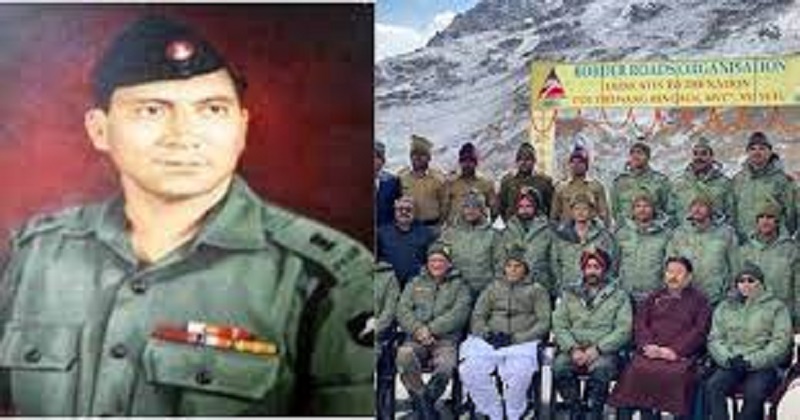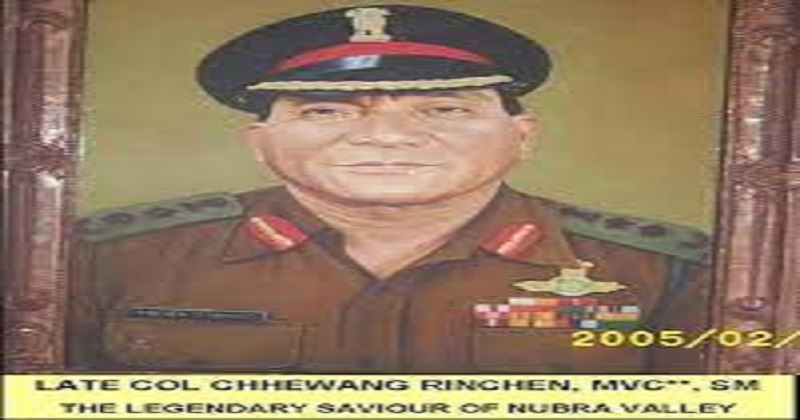
Strongly patriotic, sincere, and a distinguished soldier who embraced India is how Phunsog Angmo remembers her father, Col Chewang Rinchen, after whom the nation’s highest altitude all-weather strong bridge has been just labeled.
The strategically significant 400-meter all-weather bridge in Eastern Ladakh not only combines Darbuk with Daulat Beg Oldi (DBO), just 45 km from the LAC with China but also gives a requisite bond for the people of Ladakh living in the interior regions with mainland India. It is most aptly baptized Colonel Chhewang Rinchen Setu after the ‘Lion of Ladakh’, who battled all the four wars while his Army career, 1947-48, 1965 and 1971 against Pakistan and 1962 against China and was succeeded in all.

Chhewang Rinchen was born on November 11, 1930, at Sumur village in Nubra valley, north of Leh. In Nubra, his great grandfather was presented with the title ‘Lion of Ladakh’ for his courage, and his mother was honored as ‘Mother of Nubra’ for her kindness. Very early in his life, Chhewang obtained both attributes; courage from his great grandfather and kindness from his mother.
The attack of Kashmir by Pakistan began in October 1947, placing Ladakh in danger from the Gilgit-Baltistan invaders from the north. After Leh and regions east of it were remote from mainland Kashmir, news arrived rather late. Chhewang was then in 10th standard studying at Leh. While he was waiting for his results, he discovered that Pakistani invaders had entered Zojila and were directing towards Leh. He also learned that another pole for the invaders to enter Leh was through Gilgit-Skardu-Turtuk through Nubra valley, his homeland. It was June 1948.

Chhewang, who was about 17-and-a-half, without notifying anybody, moved back to his village with a purpose: not to let the enemy invade upon Nubra. During his wild progress from village to village for 10 days, he assembled 28 volunteers, called them ‘Nubra Guards’, and reported to the most adjacent Army station at Turtuk to enter the battle to prevent the invaders from accessing the valley. After about 10 days of essential training in fieldcraft and managing weapons, Chhewang, along with his group of Nubra Guards, officially entered the 7th J&K Militia as a soldier on July 25, 1948. The cardinal traits of Sepoy Rinchen’s resourcefulness, leadership features, and loyalty to his paltan — did not go unnoticed; just about a month later, he was promoted to the position of Jemadar.
In September 1948, Jemadar Chhewang Rinchen of 7th J&K Militia, while settling a height of 17,000 feet under thick snow and extremely cold weather, started the attack by the 28 Nunus (Ladakhi term for the young ones) onto the invaders and recaptured the tactically significant Lama House from the opponent in Nubra sector. In a different brave action, having advanced for three days through dense snowstorms, he began a violent attack on the most dominating point near Biangdangdo and captured it. This move was quickly ensued by the acquisition of Tukkar Hill, the last enemy bastion in Leh tehsil, which included the passage of a snow-clad mountain over 21,000 feet. While the last step, half of his platoon was experiencing frostbite but under his encouraging leadership and watching his example of personal courage, his men achieved the apparently difficult action.
For his courageous act of getting on the enemy far above in number, and regaining the lost ground, Jemadar Chhewang Rinchen was bestowed with the Maha Vir Chakra, becoming the youngest to receive the second-highest gallantry decoration. On June 1, 1959, Rinchen, MVC, presently a Subedar, was awarded Temporary Commission and was posted to 14 J&K Militia as Second Lieutenant. In the 1962 India-China battle, he was given the Sena Medal for leading a rescue patrol near Chandni Post in DBO. While the war with Pakistan in 1965, Chhewang Rinchen, presently a Captain, was Stated in Dispatches for his praiseworthy performance in supporting the region in Nubra valley which he had recaptured in 1948.
In 1971, now a Major, he directed a company-sized composite unit called ‘Dhal Force’ against a firmly held Pakistani station on Point 18402. After a sharp conflict, the force triumphantly regained one of the highest captured in Ladak and also the tactically important and firmly held Chalunka fixation of the enemy. Perceiving the opponent in quick defense, he daringly exploited the success and seized almost 800 sq km of the Turtuk region which was in unauthorized control of the Pakistan army. For this brave action against all possible odds, he was bestowed the Bar to the Maha Vir Chakra (the award-winning the second time). The battle account reads:
“Major Chhewang Rinchen of Ladakh Scouts was the commander of the force assigned the task of capturing the tactically vital and strongly held Chalunka complex of the enemy in Partapur sector north of Leh. The complex consisted of nine strongly held positions, each fortified with mine and wire obstacles. Major Rinchen planned and executed the operation with professional competence and great zeal. Under most adverse weather conditions, Major Rinchen led his men displaying aggressive spirit and cool courage, moving from bunker to bunker, exhorting and encouraging his men to destroy the enemy, making the operation a complete success.”

Chhewang Rinchen left from active service in 1980. Though, on popular recommendations, he rejoined the Army in 1983 in the rank of Lieutenant Colonel. Before his final retirement in 1985, he has bestowed the honorary rank of Colonel. Not just the 400-meter Darbuk-DBO Bridge in Eastern Ladakh, another strategically vital post in Siachen Glacier is named Rinchen Post. Chhewang Rinchen is not just the youngest Maha Vir Chakra awardee, the award he got twice; he is the only awardee in the Indian Army to have been decorated during all the wars he encountered while on duty.
The 1971 India-Pakistan war in the northern theatre, comprising the boundary from J&K in the west to Eastern Ladakh, witnessed the rise of three more Maha Virs, Colonel Uday Singh, Subedar Mohinder Singh, and Brigadier ML Whig. Col Uday Singh, son of Khet Singh, a Rathore Rajput from Gharaha village in Jodhpur, after matriculation from Sir Pratap Singh High School, Jodhpur, joined the Joint Services Wing (JSW) and was commissioned into 8th Gorkha Rifles on June 4, 1950. In 1971, Uday, presently a Colonel, was awarded the command of three Ladakh Scouts infantry companies and a part each of mortars and machine guns to regain Indian dominion from Chalunka to Turtuk north of Leh, held strongly by a PoK infantry battalion in Nubra.
The duty included progress on manpack and animal transport, often by night, at a sub-zero temperature at an elevation up to 18,000 feet and beyond. It is due to the sheer courage and bravery of Colonel Uday and his Gorkhas battling against all likely chances that today, not just Tyakshi, Turtuk, and Chalunka, but also approximately 800 sq km area is back where it belonged, India. For his outstanding gallantry, exceptional leadership, and great courage in the front of the enemy superior in number during this 10-day victorious operation, Col Uday Singh was bestowed with the Maha Vir Chakra.
Subedar Mohinder Singh, son of Sardar Bodh Singh, was a native of Sham Nagar village in Amritsar district. During the 1971 war, while leading No. 9 platoons of ‘C’ Company, a Sikh company of 18 Punjab, in the Kargil sector, he moved way beyond the request of duty and undeterred directed his unit upward from the front for the capture of a height that had resisted capture by the Indian Army’s earlier trials twice over. Later approaching the assaulting range, he cried ‘Bole So Nihal’ and before the powerful Sikhs of No. 9 platoons of 18 Punjab served with the iconic words ‘Sat Sri Akal’, they were already stabbing one enemy after the other just short of the aimed height, with Subedar Mohinder in the front. After half an hour of hand-to-hand combat, the highest point, that faced the Srinagar-Leh highway, was back with the Indian Army.
After the ceasefire on September 23, 1965, viewing the deals, the Pakistan army seized several important Indian positions in the Poonch and Kargil areas. Both required to be regained, the ones in the Kargil sector on preference since some of these faced the Srinagar-Leh highway from where, with observed artillery fire, the enemy could prevent the transport carrying supplies for the Indian Army working right up to the LAC in Eastern Ladakh. For his brave plan, and quite often, being in the lead to ensure its killing, Brig Mohinder Lal Whig, ex Gorkha Rifles, son of Sardari Lal Whig of the reputed Whig family of Amritsar, while driving 121 Independent Infantry Brigade Group, was also granted the Maha Vir Chakra during the 1971 India-Pakistan war.

Post Your Comments